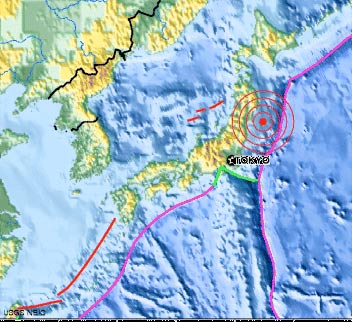The Science Behind Japan's Deadly Earthquake


The fifth largest earthquake ever recorded hit Japan today (March 11), sending huge tsunami waves crashing onshore and reportedly killing at least 300 people.
The 8.9-magnitude earthquake struck at 2:46 p.m. local time (12:46 a.m. EST), near Honshu, Japan, an island that is home to about 100 million people. The temblor was the fifth in the past two days to hit the region, and major aftershocks can be expected for months, possibly even a year. Despite the massive foreshocks, there was no way to predict that Japan's biggest-recorded earthquake was looming, said Paul Caruso, a geophysicist with the U.S. Geological Survey (USGS) in Golden, Colo.
"We have big quakes there all the time," Caruso told OurAmazingPlanet. For all scientists knew at the time, the 6.3-magnitude quake that struck yesterday was the main shock, Caruso said. "Not every big earthquake has a foreshock but they all have aftershocks." [Continued coverage of the Japan disaster]
Aftershock alert
The rule of thumb for seismologists is that an earthquake's largest aftershock will be one magnitude smaller than the main shock, Caruso said. That means a 7.9-magnitude earthquake could hit the region even a year from now. Yet aftershocks are already hitting northern Japan now — 35 larger than magnitude 5.0 and 14 larger than magnitude 6 — according to the UGSS.
Big aftershocks are not unusual. In February, a 6.6-magnitude aftershock ruptured near Maule, Chile — almost a year after what is now the sixth largest earthquake in recorded history, a magnitude 8.8, hit in the same region.
The Japanese earthquake ruptured near the boundary between the Pacific and North American tectonic plates — huge, moving slabs of the Earth's crust. The quake was a megathrust earthquake, where the Pacific plate dove underneath Japan at the Japan Trench. The seafloor was pushed away from Japan sending waves roaring toward Hawaii and the West Coast of the United States.
Get the world’s most fascinating discoveries delivered straight to your inbox.
"The tsunami wave speed in deep water, open ocean, is about the same as a commercial jet's ground speed," said Ken Hudnut, a USGS geologist in Pasadena, Calif.
The epicenter of today's quake was about 15.2 miles (24.4 kilometers) deep, according to the USGS, which is near enough to the surface to set off a tsunami.
"Generally we don't get a tsunami unless we have a shallow quake, and that's exactly what happened," Caruso said.
Foreshocks, not forewarning
Today's earthquake was preceded by a series of large foreshocks over the previous two days, beginning on March 9 with a magnitude 7.2 quake about 25 miles (40 km) away, and continuing with three other earthquakes greater than magnitude 6, according to the USGS.
Japan's latest national seismic risk map gave a 99 percent chance of at least a magnitude 7.5 quake hiting the region in the next 30 years, Robert Geller, University of Tokyo geophysicist, told Science Magazine, but today's quake was more than 100 times powerful.
Earthquakes in the region are common, because Japan lies along the volatile Pacific Ring of Fire — a narrow zone around the Pacific Ocean where a large chunk of Earth's earthquakes and volcanic eruptions occur. Roughly 90 percent of all the world's earthquakes, and 80 percent of the largest ones, strike along the Ring of Fire.
The Japan Trench has seen nine events of magnitude 7 or greater since 1973. The largest of these was a magnitude 7.8 earthquake in December 1994, which caused 3 fatalities and almost 700 injuries, approximately 160 miles (260 km) to the north of today's quake. In June of 1978, a magnitude 7.7 earthquake about 22 miles (35 km) to the southwest caused 22 fatalities and over 400 injuries.
The epicenter of the earthquake was 231 miles (373 kilometers) northeast of Tokyo and 80 miles (130 km) east of Sendai, Honshu, according to the USGS.
Brett Israel is a staff writer for OurAmazingPlanet, a sister site to LiveScience. Email Brett at bisrael@techmedianetwork.com. Follow him on Twitter @btisrael.


